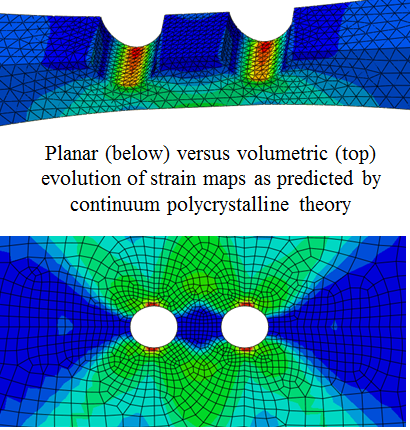Under the appropriate stress and thermal conditions, Shape Memory Alloys (SMAs) exhibit the ability to fully recover large deformations via "superelasticity" or "pseudoelasticity". The main objective of this work is to observe size effects and granular constraints in the elastic and transformation regimes of NiTi based SMAs. Experimental results (using diffraction and imaging techniques) reveal the strain and transformation maps of SMAs, which are compared with similar maps obtained from predictive models.


Micromechanics of Shape Memory Alloys
Under the appropriate stress and thermal conditions, Shape Memory Alloys (SMAs) exhibit the ability to fully recover large deformations via "superelasticity" or "pseudoelasticity". The main objective of this work is to observe the effects of grain size and granular constraints in the elastic and transformation regimes of SMAs. For planar samples, where plane stress conditions hold, Digital Image Correlation is used to observe local surface strains with EBSD providing the necessary crystallographic information. These results, when compared with simulations based on a phenomenological continuum based model also point towards the break down of continuum mechanics and application of micro-mechanical models. High energy x-ray diffraction microscopy (HEDM) experiments (conducted at the Argonne National Lab and Cornell High Energy Synchrotron Source) are conducted for three dimensional dog bones under loading in the superelastic regime to allow for 3D grain reconstruction and strain mapping at the sub-grain level.
Micromechanical characterization
SMA constitutive modeling: 1D Model, 3D Models, Multivariant Model
Porous and Composite SMA Modeling

A three-dimensional macroscopic constitutive model that accounts for the elastic, phase transformation, reorientation and plastic strains was developed to characterize the behavior of shape memory alloys. This model was then implemented in Abaqus via a user subroutine VUMAT, which can be applied for the computation of various SMA structures. Porous and composite structures, due to their additional beneficial properties, are the two applications of SMA that especially interest the researchers. By employing the aforementioned constitutive model, various geometric configurations of porous and composite SMAs are created and simulated in Abaqus. Study is focused on the effect of geometric factors, such as number, size, distance of pores in porous SMAs, as well as the number, location, orientation, length and pre-strain of SMA wires in the SMA-reinforced composites. This modeling methodology serves as an efficient tool for providing insightful conclusion for the design and optimization of porous and composite SMAs.
Porous Materials

Part of our research has focused on modeling and characterization of porous materials, with application to bone implants. Due to the huge stiffness mismatch between solid metallic alloys and natural bone, problems with existing bone implants include a poor implant-bone interface and so-called stress-shielding, by which the higher stiffness implant detrimentally bears most of the biological loads, resulting in resorption of the surrounding bone. In collaboration with Professors Dunand and Stupp we have examined porous titanium and porous NiTi (SMA) to help solve these problems for bone implant applications. The bulk of our work has been modeling of the porous materials, creating randomized 2D and 3D microstructures, tackling some of the difficult issues of representative volume elements. Recently we have implemented a robust 3D SMA constitutive law in Abaqus to elucidate the nature of the phase transformation in these porous microstructures.